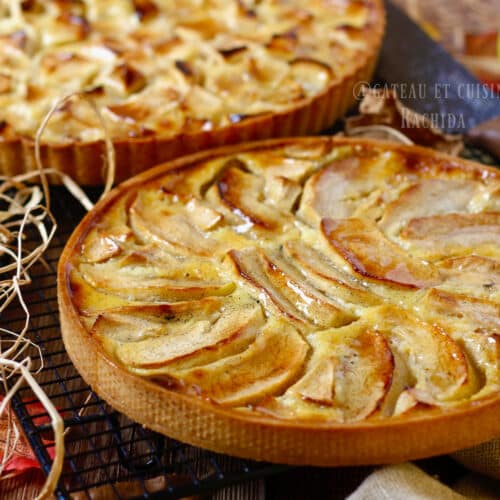
French Apple Custard Tart Recipe
French Apple Custard Tart “Tarte Normande aux Pommes” with a buttery, crisp shortcrust pastry, apple slices, and custard for a rich, flan-like texture
SERVING:10
PRINT
PIN
SAVE
INGREDIENTS
- For a 24 cm × 2 cm (9.4 in × 0.8 in) or 28 cm × 3 cm (11 in × 1.2 in) tart ring.
Sweet Shortcrust pastry
- This quantity will allow you to line two 22 cm (8.6 in) tart rings, or one 24 cm (9.4 in) ring and one 18 cm (7 in) ring.
- 250 g (8.8 oz) all-purpose flour
- 130 g (4.6 oz) butter, cold but not hard, cut into small pieces
- 100 g (3.5 oz) powdered sugar
- 30 g (1 oz) almond flour (optional)
- 1 large egg (60 g / 2 oz ) to be adjusted according to the flour's absorption
- 1/3 teaspoon salt (1 g)
- 1 vanilla pod optional
The custard
- I had a little left over which I used to make a small tart.
- 125 ml (4.4 oz) heavy cream
- 125 ml (4.4 oz) whole milk
- 80 g (2.8 oz ) granulated sugar
- 125 g eggs (4.4 oz) without shell (2 large eggs)
- vanilla beans or 1 sachet vanilla sugar.
For the filling and finishing
- 3 or 4 golden apples you may use less
- Neutral glaze apricot jam or powdered sugar
- Vanilla beans optional
PREPARATION
Sweet Shortcrust pastry :
- In a large mixing bowl or the bowl of a stand mixer fitted with the paddle attachment, sift the flour and powdered sugar. Add the salt, almond flour and vanilla beans, then mix.
- Add the cold butter cut into small cubes, then rub the mixture together with your hands or use the stand mixer to work it until you get a breadcrumb-like texture, with no lumps of butter remaining.
- Add the beaten egg and mix briefly until the dough begins to form. If the dough is dry, add a little more egg.
- Note: Don't overwork the dough to avoid activating the gluten, as this can cause the dough to collapse in the mold.
- Turn the dough onto the work surface and press it with the palm of your hand, pushing it forward 2 to 3 times to obtain a smooth dough without pieces of butter
- Form into a ball, flatten into a disk and wrap in cling film. Leave to rest in the fridge for at least 2 hours.
- Roll out the dough between two sheets of parchment paper to a thickness of 2-3 mm, making it slightly larger than your tart ring. If it sticks, firm it up in the fridge.
- Place the rolled-out dough into the buttered tart ring, preferably set on a perforated baking sheet, and lined with a Silpain mat or parchment paper. Press well on the sides and bottom of the mould to form a right angle. Trim the excess dough with a rolling pin, then level the edges with a knife for a neat finish.
- Place the mold in the freezer for 30 minutes to 1 hour.
- Bake blind or go straight to the filling. Preheat the oven to 160°C (320°F) fan-assisted or 170°C (340°F) static.
- Bake for about 15 minutes, until lightly golden, then cool before garnishing. I slightly exceeded the baking time for the small tart because usually, the crust should be a little less golden
Custard :
- Whisk the eggs with the sugar and the seeds of the scraped vanilla pod or vanilla sugar in a mixing bowl.
- Add milk and heavy cream and mix until smooth.
Filling and Baking :
- Preheat the oven to 180°C (350°F) with conventional heat.
- Peel the apples, remove the core, and cut them into fairly thick slices or wedges, depending on your preference. I cut mine into 1.5 cm (about 0.6 inches) thick wedges, but often the apple is cut into eighths. Sprinkle with lemon juice to prevent oxidation.
- Fill the tart shell by arranging the apple pieces or by fanning the wedges, filling any gaps with additional apple pieces.
- Fill with custard up to 3 mm from the edge. Do not fill to the top to prevent the custard from overflowing.
- Bake for 45 minutes, more or less depending on your oven, until the top is golden and the cream has set. If the top browns too quickly before the tart is cooked, cover with aluminum foil.
- Note: A dozen minutes before the end of cooking time, sprinkle with brown sugar and finish cooking. This will caramelize the apples slightly.
- Place the tart on a wire rack and allow to cool slightly before removing the ring. Let it cool completely before brushing on a bit of neutral glaze or warmed, strained apricot jam with a pastry brush.
- I add the seeds of a large vanilla pod to the neutral glaze for extra flavor and an even prettier finish. You can also simply dust it with powdered sugar or serve it as is.
- Your French apple tart is ready to enjoy, bon appétit!